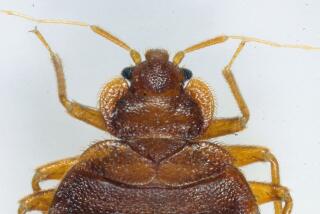There are enemies at our door
- Share via
YOU are not alone. Right there, in the sanctuary of your home, any number of tiny uninvited guests have set up residence, with no plans of leaving any time soon.
In “A Field Guide to Household Bugs,” a paperback due in stores this month from Plume Books, authors Joshua Abarbanel and Jeff Swimmer bring this disgusting reality home with 115 pages of humorous factoids and skin-crawling photographs of earwigs, silverfish and other freeloading domestic varmints. The authors will appear at 2 p.m. Sept. 30 at Dutton’s Brentwood. In the meantime, Abarbanel offers insights into the bug versus homeowner mismatch:
--
What’s the most common household pest included in the book?
Dust mites. Flies and ants come and go, but dust mites are in for the long haul. Ten percent of the weight of a 2-year-old pillow may be composed of dead dust mites, molted exoskeletons and mite droppings. When you go to sleep at night, you’re sharing your bed with 100,000 to 10 million of these little critters.
--
Which of the bugs are the toughest to control?
Bedbugs are getting a lot of press as infestations continue to pop up in cities across the U.S. and beyond. Just why they have come back is a mystery, but the suspected culprits are cheap global travel and the banning of powerful pesticides like DDT.
Bedbugs are essentially immune to the available pesticides, and they can hide in any crack along the floor or wall, not just in a mattress or bed frame. You would never think of a bug as being patient, but these guys can go a year without a blood meal, waiting for just the right moment to dine. It’s no wonder the word bug comes from the Celtic word for a ghost or goblin, because bedbugs were considered terrors of the night.
--
The mighty cockroach gets some major props in the book for sheer invincibility. Is the homeowner’s plight against them as hopeless as it seems?
It’s true that the cockroach and a lot of their bug cousins could survive a nuclear attack and will probably be here long after we are all gone. They are evolutionary wonders and have survived for millions of years with tricks up their vile little sleeves.
Young roaches have at least 14 “breaking points” on their bodies at which they can part and still survive. Their waxy, bendable shell allows them to burrow into cracks as thin as a quarter. They have ferocious jaws, and ultra-sensitive antennae allow them to smell water.
Amazingly, the unfertilized eggs of the American female cockroach can produce more females, so though this creature may be disgusting, it’s also an evolutionary masterpiece.
--
Where would we start a counteroffensive? Which room is most likely infested?
The place with the most action is probably the kitchen.
Of the bugs that actually snack upon us, the bedroom is a favorite playground, where the mild temperatures, soft bedding and huge, yummy, blood-filled hosts unknowingly offer free admission to an all-night buffet.
More to Read
Sign up for our Book Club newsletter
Get the latest news, events and more from the Los Angeles Times Book Club, and help us get L.A. reading and talking.
You may occasionally receive promotional content from the Los Angeles Times.







